Orioles' Bundy relies on patience, his brother in injury comeback

SARASOTA, Fla.—Orioles pitcher and top prospect Dylan Bundy has been a hunter most of his life, so he’s used to sitting motionless for hours waiting for a deer to walk by. But when faced with the idea of spending the better part of a year taking it easy as he recovered from June 2013 Tommy John surgery, he had no idea how to handle it.
“When it comes to baseball,” he says, “patience is hard for me.”
Bundy, a 22-year-old righthander, considers a good workout to be digging a four-by-four-foot hole and filling it up again, or running sprints with a 75-pound sandbag over his shoulder, or flipping a 900-pound tire. But as it turns out, patience was just what he needed.
“It might be the best thing that ever happened to him,” says Baltimore manager Buck Showalter of the operation. “I think what made it click was the surgeon’s scalpel.”
Why the Red Sox' starting rotation doesn't need an ace to succeed
No one in the organization questions Bundy's work ethic, but there was concern that the former first-round pick of the 2011 draft was putting himself at risk for injury. “It doesn’t contribute to [the ligament damage]," Showalter says of high-stress workouts. “It’s usually the cause.” That Bundy trained with such a fervor should be no surprise: He and his 25-year-old brother Bobby, a 2008 eighth-round pick who is also righthanded and has pitched as high as Double A in the Baltimore organization, grew up pushing themselves as hard as they could. Both have paid a price: Bobby had his own Tommy John surgery three months after Dylan’s.
Not long after Dylan and Bobby went under the knife, their mother, Lori, died suddenly in early December 2013. Baseball became an escape for the Bundys, who each went through long rehab periods, working to get back onto a mound. After the '14 season, the brothers went home to Owasso, Okla., and played catch with their dad, Denver. In January, Dylan moved to a rented house in Sarasota, with Bobby following in February. They spent four months living together and working out together at the Orioles’ spring complex, the first time they’d been able to spend extended time together since high school.
Dylan was farther along in his Tommy John rehab than Bobby, but Bobby had undergone arm surgeries before, so they were able to compare notes. Hey, I’m kind of sore here today.Yeah, I went through that, give it a week.
Zack Wheeler tears UCL, but do Mets share blame for his injury?
“It was nice to bounce ideas off each other,” Bobby says. “You don’t want to go through the surgery, but both of us being down here at the same time kept us sane for the most part. It’s a blessing.”
They attempted to follow Baltimore's program to the letter, but did allow themselves one exception: In February, when they were cleared to use stationary bicycles, they bought a pair of trail bikes. They rode through fields to keep themselves busy and integrated them into their workouts. In truth, even that wasn’t enough for Dylan. A few weeks in, he was messing around with his bike and managed to attach a chainsaw motor to it, then got up to 20 miles per hour on it.
The spring has been an uneventful and welcome relief for Dylan, who didn’t pitch at all in 2013 and made only nine starts in A-ball last year before a strained right lat muscle shut him down in August. So he was elated after pitching against the Tigers on March 4, his first live inning in seven months. “My fastball command wasn’t there, but I was happy with the way the ball came out of my hand,” he says. “Health-wise, I felt great. It was a success.”
Weaver, Volquez, Hunter among AL's bust candidates for 2015
His numbers have been unimpressive in his four outings so far this spring, and his fastball has sat in the 91-92 mph range, but command and velocity are two of the slowest elements to return after Tommy John surgery.
“Dylan threw some good sequences,” Showalter said after Bundy’s second outing. “He’s right where he needs to be.”
As Dylan has succeeded as a starter and Bobby has transitioned to relief pitching, they’ve developed a new goal: for a major league box score to read “Bundy, Bundy.” They got partway there, with both names in a spring training box score on March 12, when Bobby relieved Mark Hendrickson, who had relieved Dylan.
Bobby’s recovery was difficult—he’d had bone spurs removed from his elbow in 2012, and then again two months before the UCL reconstruction—but he’s healthy now, feeling the best he has in three years. In his first live appearance of the spring, he pitched 2/3 of an inning, notching one strikeout.
Carrasco, Quintana among AL's breakout candidates for 2015 season
And Dylan is almost back to where he was before the surgery, when he rocketed through the minor leagues in 2012 to become Baseball America’s No. 2 prospect. That year, he allowed no earned runs over 30 innings in eight starts at Class A Delmarva and finished the minor league season with a 2.08 ERA and 119 strikeouts over 103 2/3 innings at A-ball and Double A. Six weeks before his 20th birthday, he made his major league debut, throwing 1 2/3 scoreless innings.
Through all the rehab and work, Dylan has learned a lesson that should help protect his body down the road: To maximize his abilities, he needs to train smart, not just hard.
“I felt like I was in the best shape when I did that stuff,” he says, “but it depends on what kind of shape you’re looking for. As a pitcher you don’t need to be all big in the upper body. You need to be able to repeat your mechanics. Flipping a tire twice isn’t gonna help you throw 100 pitches in a game.”
He’ll likely start the season at Double A Bowie, but it won’t be long before he’ll be taking aim at major league prey.
